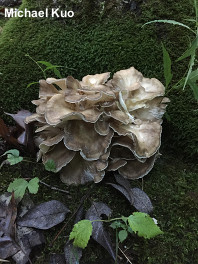| Major Groups > Polypores > Stemmed, Pale-Fleshed > Grifola frondosa |

|
Grifola frondosa [ Basidiomycota > Polyporales > Grifolaceae > Grifola . . . ] by Michael Kuo Grifola frondosa, sometimes called the "hen of the woods" and the "maitake," is a soft-fleshed polypore recognized by its smoky brown, wavy caps, which are organized in large clusters of rosettes arising from a single, branched stem structure. It is usually found near the bases of oaks, where it causes a butt rot. It is similar to Meripilus sumstinei (which has larger individual caps, smaller pores, and surfaces that bruise black) and to Polyporus umbellatus (which has more clearly defined individual caps and stems). Microscopic features will also help separate these species. Regarding the putative "medicinal" properties of this mushroom: I am sorry to put it this bluntly, but this mushroom is not going to cure your cancer, nor any other ailment you may have—and if someone has sold you a product based on the assumption that it will, you have purchased some snake oil from a witting or unwitting charlatan. The only health benefits associated with consuming Grifola frondosa result from the exercise involved with hunting for it in the woods. There is no legitimate scientific support for the idea that mushrooms are medicinal. None. There is only pseudoscience, bad science reporting in the mainstream news media, and very wishful science reporting in the alternative health media. For further information, see Nicholas Money's "Are mushrooms medicinal?" (2016). Description: Ecology: Weakly parasitic on living oaks and other hardwoods; also saprobic on decaying wood; causing a white butt rot; fruiting near the bases of trees; often reappearing in the same place in subsequent years; summer and fall; widely distributed east of the Rocky Mountains, rare in the west. The illustrated and described collections are from Illinois. Fruiting Body: 15–40 cm across; 10–30 cm high; composed of multiple caps in a rosette, sharing a branched, stemlike structure. Individual Caps: 3–14 cm across; more or less fan-shaped or deltoid; dark to pale gray-brown (often with vague concentric zones); yellowing with old age; finely velvety or bald; with wavy margins. Pore Surface: Running down the stem, often nearly to the base; lavender gray when young, becoming white and, with age, staining yellowish; not bruising; with 1–3 angular to slot-like or nearly tooth-like pores per mm; tubes 1–3 mm deep. Stem Structure: Branched; whitish; tough; often off-center. Flesh: Firm; white; unchanging when sliced. Odor and Taste: Mild; pleasant. Chemical Reactions: KOH negative on flesh and surfaces. Iron salts negative on cap and flesh. Spore Print: White. Microscopic Features: Spores 4–6 x 3–4 µm; ellipsoid; smooth; hyaline in KOH, often with one large oil droplet; inamyloid. Basidia 25–30 x 6–8 µm; clavate; 4-sterigmate. Hymenial cystidia not found. Hyphal system dimitic. Clamp connections present on generative hyphae; absent on skeletal hyphae. REFERENCES: (Dickson, 1785) S. F. Gray, 1821. (Fries, 1821; Saccardo, 1888; Overholts, 1953; Smith, Smith & Weber, 1981; Arora, 1986; Gilbertson & Ryvarden, 1986; Phillips, 1991/2005; Lincoff, 1992; Horn, Kay & Abel, 1993; Roody, 2003; McNeil, 2006; Miller & Miller, 2006; Kuo, 2007; Binion et al., 2008; Kuo & Methven, 2014; Money, 2016; Justo et al., 2017.) Herb. Kuo 10070305, 10021603, 10221601. This site contains no information about the edibility or toxicity of mushrooms. |
© MushroomExpert.Com |
|
Cite this page as: Kuo, M. (2017, October). Grifola frondosa. Retrieved from the MushroomExpert.Com Web site: http://www.mushroomexpert.com/grifola_frondosa.html |







